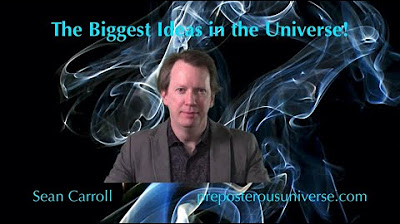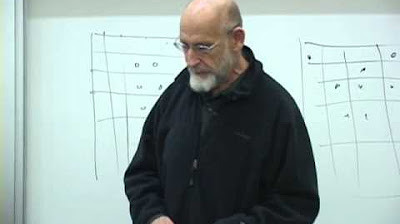Solving Wordle using information theory
TLDRThe video explores the application of information theory and entropy in the popular word puzzle game Wurdle. It delves into the process of creating an algorithm to optimize gameplay, discussing strategies like starting with common words and using entropy to measure the effectiveness of guesses. The algorithm iteratively refines its strategy based on gained information, aiming to minimize the number of guesses required to solve the puzzle. The video also touches on the historical naming of 'entropy' in information theory and its connection to probability and uncertainty.
Takeaways
- 📈 Wurdle, a popular word puzzle game, serves as an excellent example for teaching information theory and entropy.
- 🤖 The speaker developed an algorithm (Wurdle bot) to play the game optimally, focusing on maximizing information gain with each guess.
- 🎯 The goal of Wurdle is to guess a five-letter mystery word with six attempts, receiving feedback after each guess to narrow down possibilities.
- 🔍 The bot's strategy involves calculating the entropy of different opening guesses to determine which provides the most information.
- 📊 Entropy is measured in bits, with higher entropy indicating a flatter distribution and more uncertainty, leading to more effective guessing.
- 🧠 The concept of entropy in information theory is related to the expected information value of a guess and the remaining uncertainty after each guess.
- 📚 The speaker used word frequency data from English language sources to refine the bot's strategy, giving more weight to common words.
- 🔢 The bot's algorithm was improved by incorporating a model of the probability that each word is the actual answer, influencing decision-making.
- 📈 The speaker's simulations showed that the refined bot could solve the game with an average score of around 3.6, with the best performance reaching 3.43.
- 🤔 The speaker suggests that an ideal algorithm, even with the true list of Wordle answers, may not average lower than three due to the nature of the game.
- 🌐 The speaker's exploration of Wurdle through the lens of information theory provides insights into probability, pattern recognition, and algorithm optimization.
Q & A
What is the main objective of the game Wurdle?
-The main objective of Wurdle is to guess a mystery five-letter word within six attempts, using the feedback provided after each guess to narrow down the possibilities.
How does the Wurdle bot determine its first guess?
-The Wurdle bot determines its first guess by considering the relative frequencies of letters in the English language, aiming to hit as many common letters as possible to gain information early in the game.
What is entropy in the context of information theory?
-In information theory, entropy is a measure of the expected amount of information gained from a particular guess, essentially quantifying the uncertainty or surprise in the outcome of an event.
How does the Wurdle bot use entropy to optimize its guesses?
-The Wurdle bot uses entropy by calculating the expected information value of each possible guess and selecting the one with the highest entropy, which is expected to reduce the search space the most with each guess.
What is the significance of the word 'weary' in the context of the Wurdle bot's strategy?
-The word 'weary' is significant because it contains uncommon letters like 'W' and 'Y', and its use demonstrates the consideration of less common letters in the bot's strategy to potentially gain more information if such a letter is in the target word.
How does the Wurdle bot incorporate word frequencies into its algorithm?
-The Wurdle bot incorporates word frequencies by using a sigmoid function on a sorted list of words based on their frequency in the English language, to assign a probability to each word of being the final answer, thus weighting common words more heavily.
What is the role of the expected value of information in the Wurdle bot's decision-making process?
-The expected value of information helps the Wurdle bot to rank potential guesses by how much information, on average, they are expected to provide, which in turn helps to minimize the number of guesses needed to find the mystery word.
How does the Wurdle bot handle the trade-off between maximizing information and reaching the goal?
-The Wurdle bot handles the trade-off by considering not only the expected information gain from a guess but also the probability of each word being the actual answer, allowing it to prioritize guesses that are both informative and likely to be correct.
What is the best average score achieved by the Wurdle bot when incorporating the true list of Wordle answers?
-The best average score achieved by the Wurdle bot when incorporating the true list of Wordle answers is around 3.43, which represents the average number of guesses needed to solve the puzzle.
What is the significance of the opening guess 'crane' in the context of the Wurdle bot's performance?
-The opening guess 'crane' is significant because, after performing a two-step search and running simulations, it was found to be the best opener, suggesting that it is an optimal starting point for reducing uncertainty early in the game.
How does the Wurdle bot's strategy change when it incorporates a model of the probability that each word is the actual answer?
-When the Wurdle bot incorporates a model of the probability that each word is the actual answer, it adjusts its strategy to consider not only the entropy of each guess but also the likelihood of each word, allowing it to make more informed decisions that balance the trade-off between gaining information and reaching the goal.
Outlines
🎲 Introduction to Wurdle and Entropy
The video begins with the host discussing the popularity of Wurdle, a word puzzle game, and its connection to information theory and entropy. The host shares their personal experience getting hooked on the game and attempting to create an algorithm to optimize gameplay. The basic rules of Wurdle are explained, where the goal is to guess a five-letter mystery word within six attempts, receiving feedback on each guess. The host introduces the concept of entropy as central to their algorithm, and explains the game's mechanics in the context of information theory.
📊 Analyzing Guess Patterns and Probabilities
The host delves deeper into the strategy behind Wurdle by examining the quality of different opening guesses. They discuss the concept of entropy in relation to the probability of certain patterns occurring and the amount of information gained from each guess. The video presents a quantitative approach to evaluating potential guesses, considering the distribution of valid words and the likelihood of guessing the correct pattern. The host also explores the idea of using the English language's letter frequencies to inform the guessing strategy and the importance of common words in the game.
🧠 Entropy and Information Theory in Wurdle
This paragraph focuses on the application of information theory to Wurdle, particularly the concept of entropy. The host explains how entropy measures the expected amount of information gained from a guess and how it can be used to rank potential guesses. They introduce the idea of using the bit as a standard unit of information and discuss the formula for calculating information in terms of probability. The host also shares a historical anecdote about the naming of entropy by Claude Shannon and John von Neumann, emphasizing the strategic advantage of using entropy in wordle-solving algorithms.
🔢 Entropy Calculation and Word Selection
The host continues to explore the use of entropy in optimizing Wurdle gameplay. They describe how to calculate the entropy for each possible guess and how to use this metric to select the best opening word. The video presents a method for refining the initial guess based on the distribution of word patterns and the likelihood of each word being the answer. The host also introduces a tool they developed, Wurtelebot, which demonstrates the entropy calculations and suggests the best guesses based on these calculations.
📈 Refining the Wordle Strategy
The host discusses the refinement of the Wurdle strategy by incorporating word frequency data to better predict the likelihood of words being the answer. They explain how they used the Google Books English Ngram dataset to assign probabilities to words and how this affects the entropy calculations. The video shows how the updated version of the Wurtelebot incorporates these probabilities and adjusts the strategy to maximize the expected information gain while also considering the likelihood of each word being the answer.
🏆 Optimal Play and Algorithm Performance
In the final paragraph, the host evaluates the performance of the improved wordle-solving algorithm. They discuss the results of simulations against all possible wordle answers and the average score achieved. The host shares their findings that incorporating word frequency data and a two-step search strategy significantly improves the algorithm's performance. They also mention that using the true list of wordle answers further refines the model, leading to an average score of around 3.43. The host concludes by suggesting that an algorithm cannot guarantee an average score lower than three due to the limitations of the available words and the information that can be gained in the initial steps of the game.
Mindmap
Keywords
💡Wurdle
💡Information Theory
💡Entropy
💡Algorithm
💡Relative Frequencies
💡Pattern
💡Expected Value
💡Sigmoid Function
💡Word Frequency Data
💡Information
💡Optimal Guessing Strategy
Highlights
Wurdle, a popular word puzzle game, serves as an excellent example for teaching information theory and entropy.
The speaker developed an algorithm to play Wurdle optimally, focusing on the concept of entropy in information theory.
Wurdle's objective is to guess a five-letter mystery word with six chances, providing feedback after each guess.
The algorithm uses feedback from Wurdle guesses to narrow down possibilities and make informed decisions for subsequent guesses.
The speaker explores the relative frequencies of letters in the English language to optimize the opening guess in Wurdle.
The concept of entropy is introduced as a measure of information and uncertainty in the game.
The standard unit of information is the bit, which quantifies how much an observation reduces the space of possibilities.
The speaker's algorithm calculates the entropy for each possible guess to determine the most informative first move.
The algorithm iteratively refines its strategy based on the pattern of feedback received from each guess.
The speaker discusses the use of a prior distribution of word likelihoods based on word frequencies from Google Books English Ngram data.
The concept of entropy is applied to measure the remaining uncertainty among possible words after each guess.
The speaker's algorithm incorporates a model of the probability that each word is the actual answer, influencing its decision-making process.
The algorithm uses a sigmoid function to create a binary distribution of word likelihoods, providing a more refined strategy.
The speaker's approach to Wordle bot development serves as a practical application of information theory in a real-world scenario.
The algorithm's performance is tested against all possible Wordle answers, aiming to minimize the average number of guesses required to win.
The speaker concludes that an ideal algorithm incorporating the true list of Wordle answers could potentially achieve an average score of around 3.43.
The concept of entropy is shown to have dual applications in the game: maximizing information gain from a guess and measuring remaining uncertainty.
The speaker's exploration of Wurdle through information theory provides insights into the balance between gaining information and reducing uncertainty.
Transcripts
Browse More Related Video
5.0 / 5 (0 votes)
Thanks for rating:





